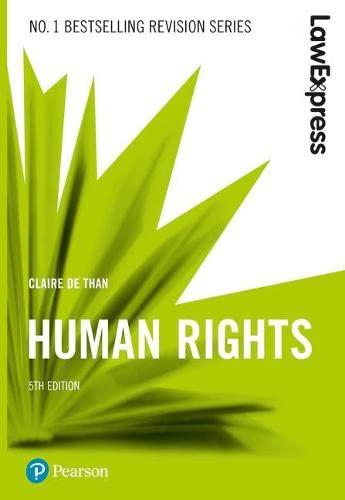Question
Case Study K (Children), Re [2019] EWCA Civ 184 The central issue of the appeal was whether the first instance judge was wrong to make
Case Study
K (Children), Re [2019] EWCA Civ 184
The central issue of the appeal was whether the first instance judge was wrong to make
a finding that the appellant father had sexually abused his 6-year-old daughter. The father
contended that the evidence was inadequate to support the judge's findings.
The background is set out at 3-7. Broadly, in summary "Anisa" had lived with her parents
and 13-year-old sister. She made allegations of physical and sexual abuse against her
father to a teacher at her mosque which, in turn, led to referrals and the father moving
out of the family home. The Local Authority initiated care proceedings and there was a
four-day fact-finding hearing. The judge made a number of threshold findings (found at
5) but the father only sought to appeal the finding of significant sexual harm against
him.
The evidence is summarised at 8-21. There were two strands to the evidence. First, the
investigation into Anisa's statements to the teacher (parts of which were unrepeated by
Anisa and thus formed the primary evidence of the Local Authority in respect of the
sexual abuse). Notably, the judge was highly critical of the process by which Anisa's
account was investigated and a list of defects is found at 16. Second, the accounts
subsequently given by the workers who supervised the father's contact, when they each
said that they had briefly seen the father with what they thought was an erection (which
supported a finding that the father had been sexually aroused at contact).
The trial judge's reasoning is found at 22-25 and the arguments on appeal from 26-
31. The father argued that the judge went beyond what the evidence allowed including
wrongly relying upon the evidence of the teacher (see 27) and erring in using the
"speculative" and "incompatible" accounts of the contact workers to bolster her main
findings.
In largely dismissing the appeal, the court reiterated that an appellate court will rarely
contemplate reversing a trial judge's findings of primary fact before listing nine fact
specific reasons (at 33) as to why the appeal failed that rigorous hurdle. The nub being
that the judge had given herself a model legal self-direction, had applied the direction to
the evidence in a clearly reasoned judgment, there was evidence to support the judge's
findings and the judge was entitled to make the findings she did.
Thus, the appeal largely failed. The only point of departure from the judge's findings was
in respect of the finding that the father had been sexually aroused at contact. Peter
Jackson LJ concluded (at 35) that the evidence of the contact workers was too uncertain
to form a sound basis for the finding such that the finding was set aside (without,
however, tainting the judge's primary finding of sexual abuse).
Summary by Max Turnell, barrister, 1 King's Bench Walk
From the case study, please help me draft a brief introduction and also conclude if there was enough evidence to support the child's claim of being sexually abused by the father.
Step by Step Solution
There are 3 Steps involved in it
Step: 1

Get Instant Access to Expert-Tailored Solutions
See step-by-step solutions with expert insights and AI powered tools for academic success
Step: 2

Step: 3

Ace Your Homework with AI
Get the answers you need in no time with our AI-driven, step-by-step assistance
Get Started


